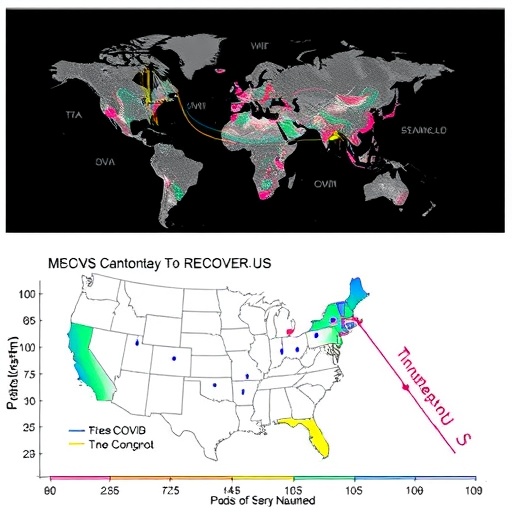In a groundbreaking study published in Nature Communications, researchers have unveiled new insights into the long-term trajectories of Long COVID among adults in the United States. This comprehensive analysis, leveraging data from the RECOVER-Adult cohort, sheds light on the complex and heterogenous nature of Long COVID, a condition that has perplexed clinicians and scientists alike since the onset of the global COVID-19 pandemic.
The RECOVER-Adult cohort is a prospectively followed group of over 4,000 adults, meticulously tracked to delineate symptom progression and recovery patterns following acute SARS-CoV-2 infection. This longitudinal design marks a significant advancement over previous retrospective studies, allowing for a more precise understanding of how Long COVID symptoms evolve over time. The investigators employed sophisticated statistical modeling to parse the heterogeneous symptom trajectories, revealing distinct subgroups of patients experiencing different recovery paths.
Central to the study is the identification of multiple symptom trajectories that elucidate the varied clinical courses patients endure. While some individuals exhibited rapid recovery within months, others displayed persistent or fluctuating symptoms extending well beyond a year. These trajectories challenge the notion of Long COVID as a monolithic condition, instead positing it as a collection of potentially overlapping syndromes with differing underlying mechanisms. The researchers highlight the critical need for personalized approaches to management and therapeutic intervention.
One of the pivotal findings relates to the symptom clusters that dominate each trajectory. Fatigue, cognitive dysfunction, and respiratory complaints emerged consistently across subgroups but in varying intensities and durations. Neurocognitive symptoms, colloquially referred to as “brain fog,” were particularly prevalent in the persistently symptomatic cohort. This underscores the multifaceted impact of Long COVID on neurological function, potentially implicating viral persistence, immune dysregulation, or microvascular injury as contributing factors—a hypothesis the authors call for further mechanistic exploration.
The study also probes demographic and clinical predictors of trajectory membership. Patients with pre-existing health conditions, older age, and female sex were disproportionately represented in the prolonged symptom groups. This aligns with earlier reports suggesting that biological sex and comorbidity profiles modulate vulnerability to chronic post-viral syndromes. The granular data from this cohort provide a valuable framework for risk stratification that could optimize resource allocation and clinical monitoring in at-risk populations.
Importantly, the research team leveraged machine learning techniques to enhance prediction accuracy of individual trajectories based on early symptom profiles and biomarkers. These computational models demonstrated promising performance, foreshadowing potential clinical applications in prognostication and personalized care pathways. Early identification of patients likely to endure prolonged symptomatology could revolutionize treatment paradigms and improve quality of life for millions.
The implications of these findings extend beyond the immediate healthcare concerns, touching upon the socioeconomic impacts of Long COVID. Persistent symptoms have been linked to diminished workforce participation and increased disability claims, signaling a looming public health challenge with profound economic repercussions. By elucidating the diverse trajectories of recovery, this study informs policy decisions and underscores the necessity for comprehensive rehabilitative services integrated within national pandemic recovery strategies.
Among the methodological strengths is the prospective follow-up coupled with rigorous symptom assessments and biomarker analyses at multiple time points. This approach mitigates recall bias and captures the dynamic nature of Long COVID, providing a robust evidence base. The inclusion of concurrent controls who had acute COVID-19 but did not develop long-term symptoms adds further validity to the differential trajectory characterization.
This investigation also highlights gaps that remain in the understanding of Long COVID pathophysiology. Although symptom trajectories are well-characterized, the biological underpinnings remain elusive. The study advocates for integrative research combining immunological profiling, viral genomics, and neuroimaging to decode mechanisms fueling symptom persistence. Such multi-dimensional inquiries are vital to uncover therapeutic targets and devise interventions capable of altering the course of Long COVID.
Furthermore, the heterogeneity among symptom trajectories challenges the design of clinical trials for Long COVID treatments. Recognizing distinct patient subgroups with differing natural histories necessitates stratified trial designs to avoid confounding and enhance signal detection. The RECOVER-Adult cohort methodology offers a blueprint for future translational research aimed at precision medicine in post-viral syndromes.
The study’s findings resonate globally, emphasizing that Long COVID is not merely a series of isolated cases but a burgeoning chronic condition with multifarious outcomes. This awareness is critical for healthcare systems worldwide as they navigate post-pandemic realities. Resources must be allocated equitably to address disparate patient needs and prevent exacerbation of health disparities often entrenched in chronic disease burdens.
In conclusion, this landmark study represents a significant leap forward in elucidating the natural history of Long COVID. Through prospective follow-up and advanced analytic techniques, the RECOVER-Adult cohort provides an invaluable atlas of symptom trajectories that can guide clinicians, researchers, and policymakers alike. As we continue to grapple with the pandemic’s long shadow, such evidence-based insights are indispensable to mitigating the prolonged harms of this enigmatic condition.
The authors underscore the urgency of continued longitudinal surveillance to monitor emerging variants’ impact on Long COVID trajectories and to understand long-term sequelae beyond the one-year mark. Sustained investment in research and comprehensive patient care models remain paramount to address this evolving public health crisis comprehensively.
This research fosters hope that, through targeted scientific inquiry and tailored therapeutic strategies, the debilitating consequences of Long COVID can be alleviated. The collective effort of the global scientific community, bolstered by innovative cohorts like RECOVER, propels us closer to unraveling the mysteries of Long COVID, ultimately ameliorating the lives of those affected.
Subject of Research: Long-term symptom trajectories and clinical outcomes of Long COVID in adults.
Article Title: Long COVID trajectories in the prospectively followed RECOVER-Adult US cohort.
Article References:
Thaweethai, T., Donohue, S.E., Martin, J.N. et al. Long COVID trajectories in the prospectively followed RECOVER-Adult US cohort. Nat Commun 16, 9557 (2025). https://doi.org/10.1038/s41467-025-65239-4
Image Credits: AI Generated
DOI: https://doi.org/10.1038/s41467-025-65239-4
Tags: adult cohort analysischronic illness post-SARS-CoV-2distinct recovery patterns in Long COVIDheterogeneous Long COVID experiencesLong COVID symptom trajectorieslong-term COVID-19 effectslongitudinal study designmultifaceted nature of Long COVIDRECOVER-US study findingsstatistical modeling in health researchsymptom progression after COVID-19understanding Long COVID syndromes





